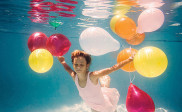How to Start in Underwater Photography
Underwater Photography
Photographs taken underwater have always been very impressive because they are not very usual. Underwater photography is a very different type of photography, but also a very difficult one. Because, first of all, you will have to dive to take those pictures and you will also need special equipment. The underwater world is very spectacular, and so are the photographs taken in that environment. However, not many people try it and those who do, are usually photographers with a sense of adventure and who want to make something different, or they are divers who have a second hobby, photography. But, if you like diving or want to try it, you should also try this type of photography as you might get some spectacular photos that would make your time and effort worthwhile.
How to start in underwater photography:
If you want to start taking great underwater photographs you should know first that there are some basic things you must take care of before you begin. One of the first things you should do is to learn how to dive. You cannot hope to achieve great pictures if you get distracted by the fact that you are under water and you don’t know what to do. Learning to dive and doing it right will give you the time you need to enjoy the underwater world and this will provide you with some great opportunities to achieve wonderful compositions.
It is difficult to take impressive pictures on land but it is even more difficult to take them underwater, especially when you don’t have all the time you might need while you are diving. If you are just beginning with underwater photography you should learn about snorkeling, a simple way to dive underwater and a much easier way than scuba diving. This is a practice of swimming underwater that is based on using simple diving equipment consisting of just a diving mask, some swim fins and a breathing tube called snorkel. The idea is that the human body floats, but not enough to make breathing over water easy. With the help of snorkeling equipment you can essentially stay underwater for hours, which is ideal if you want to take your time with underwater photography. However this is usually practiced in waters that are not very deep, sometimes near a reef or wreck. Either way, before learning to dive you should consult an instructor or take some courses, and only after you are comfortable enough with diving, you can move to photographing under water.
Another important thing you should do before taking photographs underwater is to find the right equipment for your camera, because unless your camera is waterproof you will need some special housing for it, to keep the water away.

Photo by Mohammad Alkhamis
Gear for underwater photography:
The most essential piece of equipment needed for underwater photography, apart from the camera of course, is an underwater housing. Assuming that your camera isn’t waterproof or specially designed for underwater photography, you will need to look for a special housing designed for your type of camera but, beware of the fact that not all camera models have housings available for them. You should check before getting into underwater photography if you can find an underwater housing for your camera. Underwater housings are usually made of polycarbonate, aluminium or a combination of the two and you should look for models that allow you access to the functions of the camera. Some things you should also check before buying an underwater housing are the depth rating, especially if you want to dive deep, and a support for a connection to an underwater strobe.
Underwater strobes (or underwater flashes) can be a great asset in underwater photography and sometimes are the key to a great photograph. These strobes will help you improve the quality of your photos by bringing out the impressive colors of the sea. It is recommended that you get strobes as powerful as you can afford, because light travels a lot harder underwater. You should also pay attention to the angle of coverage of a strobe, especially if you want to use wide angle lenses for underwater photography, as some strobes have an angle of coverage of less than 90 degrees which is good for macro but not for wide lenses.
The choice of lenses is also very important, because underwater, you will not be able to move as easily as on land and your subjects will also appear fast in your frame and you will have to be able to capture them easily, while maintaining a comfortable distance. Many photographers use wide-angle lenses underwater because they allow them to capture large angles of the life in the water. Fish-eye lenses are also used a lot especially because they help photographers get a closer image of large underwater creatures.
Other gear you might need when making underwater photography includes strobe arms and clamps. These are very important because it will allow you to move the strobes easily, especially if you want to light only a part of the environment.
Tips for taking great underwater photos:
– Shoot with additional light. Use flashes or strobes as they will give your pictures the light they need in order for the colors to appear like they should. Otherwise, because of the water, the images will look too blue.
– Use manual settings for the camera, or at least shoot in aperture priority mode as this will give a better control over the final result.
– Use wide angle lenses, as this will allow you to focus closer to your subject.
– Try to get closer to your subject. Because your underwater photographs will look much clearer this way, and also, the colors will be better. Shoot in macro mode if possible, with an aperture of around f/8.
– Shoot with the auto white balance turned on, as some other settings may not work properly because of the blue color of the water.
Composition techniques for underwater photography:
Just like in any type of photography, framing the subject is very important. Try filling the frame with your subject if it’s a large underwater creature, as this will provide you with great details in the shot. If you are diving with a friend, an idea would be to take his/her picture while diving, especially if he/she is near a reef or a wreck, try to include those in the frame too.
Take advantage of the fact that you are underwater and shoot up towards the light from the sun, as the light rays coming towards you through the water will look astonishing especially if the water is very clear.
If you are photographing fish or other underwater creatures try to find interesting angles to capture them. Although, one of the easiest ways to take a close-up of something in the water is from above, try to change that and shoot from below your subject or from a different angle.
Shoot with a wide aperture if you want the background to be blurred and less distracting, especially if you don’t find anything from the background to be interesting.
Use the rule of thirds. Like in any other type of photography, the rule of thirds will help you frame you subjects better.
Take advantage of the beautiful colors from the underwater world. Sometimes, the world you see while you are diving has a large variety of colors and you can capture some impressive images if you get an interesting mix of those colors.
Although underwater photography requires some dedication and effort, the outcome can be great, as the photographs taken underwater have a unique feel and they present a world that we don’t get the chance to see very often.
Some great examples of underwater photography:

Photo by DiveAddict

Photo by Kamermans

Photo by KodieJaeJae

Photo by VirtualWords

Photo by ImagesOfJenius

Photo by Hengki24

Photo by Shangova

Photo by SableDaCake
You may want to take a look at Amazing Colorful Underwater Photos
If you loved this post about underwater photography, don’t forget to add a comment in the section below.




thanks for the post..To ensure that the composition of your shot is good, try getting as low as possible and taking the picture from an upward angle. A downward angle, on the other hand, is not advised, as it will not provide you with a great shot. Normally, you would attempt to center the subject, but this will not offer the best results underwater.
Just so you know, I’m pretty sure that first photo wasn’t shot underwater. That looks like every photo I have ever seen of the jellyfish tank at the Monterey Bay Aquarium.